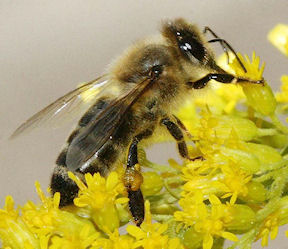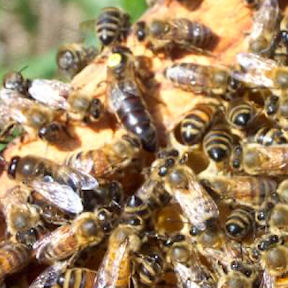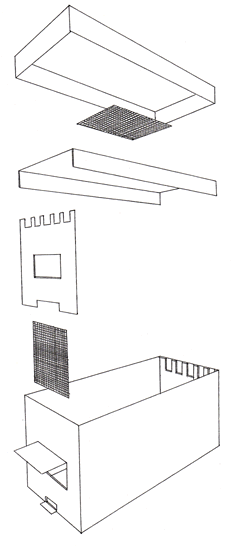I ordered a package of Carniolan bees back in February. I later decided to get another package so that I could raise two colonies. It has been suggested in more than one book that two colonies is better than one. First, you can compare hives and quickly determine when one is doing poorly and needs help. It is also insurance that if one hive dies, then you still have one hive left.
Having more than one hive, even for a beginner like me, makes sense. However, I made the decision to go with another package too late. Bees are usually sold out by March 1st; in fact, most bees are sold out by February 1st.
I found a seller in Rhode Island who has a number of nucs for sale and I ordered two. He had a kind of Italian Bee called a Minnesota Hygienic. He also had a kind called Russian. I did not know anything about the Russians, but I had read an article about the Minnesota Hygienic bees that strongly recommended them because of their natural resistance to several bee diseases. I ordered two nucs of the Minnesota Italians.
Now, after the fact, I’ve decided to look into the different bee breeds. These are all pretty much the same bee with different genetic features. They are the same species, but different subspecies or crossbreeds. They are like different races of bees, although the differences can be striking.
Golden Italian
The Golden Italian Honey bee has been the main bee of beekeepers for many years. It is a good beginner’s bee. I found a list of some of its strong points, including: Readily builds comb, Light color so it makes it easy to find a queen, Good at finding pollen, Doesn’t swarm as much as other bees, Relatively calm and gentle, resistant to foulbrood disease, Doesn’t make as much propolis (bee glue).
On the minus side, the Italians keep laying eggs and making brood even when there is no food source so they can starve if not watched. They build a lot of comb that is not for honey or brood – the structural comb called brace and burr. They drift, which means they can wander off.
The Italian bee seems to be a good all around choice.
The Minnesota Hygienic is an Italian hybrid developed by Dr. Marla Spivak at the University of Minnesota Bee Lab. They are called hygienic because they are particularly good at cleaning out sick larva and pupa, which makes them better able to fight off American Foulbrood and Chalkbrood.
Carniolan bees.
 Carniolan bees or Carnies were imported from Slovenia because they are resistant to insect pests and it is very gentle. It is almost as popular with beekeepers as the Italian Honey Bee. It is a darker brown bee, not as golden color as the Italians.
Carniolan bees or Carnies were imported from Slovenia because they are resistant to insect pests and it is very gentle. It is almost as popular with beekeepers as the Italian Honey Bee. It is a darker brown bee, not as golden color as the Italians.
There are lots of things to like about the Carniolan bee. Among other things it has a rapid buildup in early spring, even before flowers bloom. It is very gentle and non aggressive. It survives well in the winter. It regulates its size better than the Italians so it is less likely to starve as the food supply declines.
On the other hand, it swarms at the drop of a hat, especially when there is a good food supply and as pollen decreases, the size of the brood substantially decreases.
Russian Honey Bees
 Russian bees have been imported in the last 20 years because they are naturally resistant to varroa mites. Varroa mites seem to be a big problem in recently, and the Russians, coming from the place where varroa mites originated, is genetically resistant to the mites.
Russian bees have been imported in the last 20 years because they are naturally resistant to varroa mites. Varroa mites seem to be a big problem in recently, and the Russians, coming from the place where varroa mites originated, is genetically resistant to the mites.
The geneticist Thomas E. Rinderer traveled to Russia’s Pacific coast area called the Primorsky Territory in 1996. He brought back 100 queen bees. The bees proved to be mite resistant and beekeepers have been trying them out with great success.
The Russian bees have many good points. Besides mite resistance, they are good at surviving harsh winters. They have a quick spring buildup so they increase in numbers during peak honey production season.
On the minus side they tend to swarm more than other bees. Until recently they were more expensive.
There are a number of other bee types. Many of them are Brand name hybrids that have been developed at bee farms for certain characteristics. Your mileage may vary. I am hoping that we will be able to buy queens that are proven resistant to Colony Collapse Disorder.
By accident, I think I did OK. The Carniolan Bees that I ordered for May are a good bee. The Italians that I will be getting in mid April are also a good choice. I should have ordered a nuc of Russians, just so I would cover all bases, but I don’t want to get crazy. Maybe next year, when I figure out how to split a hive, I’ll get a Russian queen.


